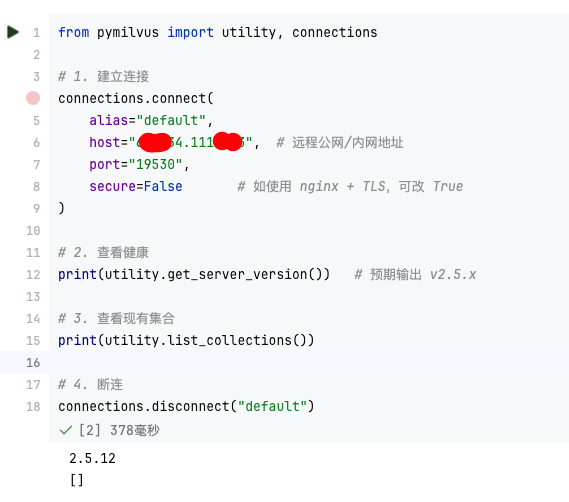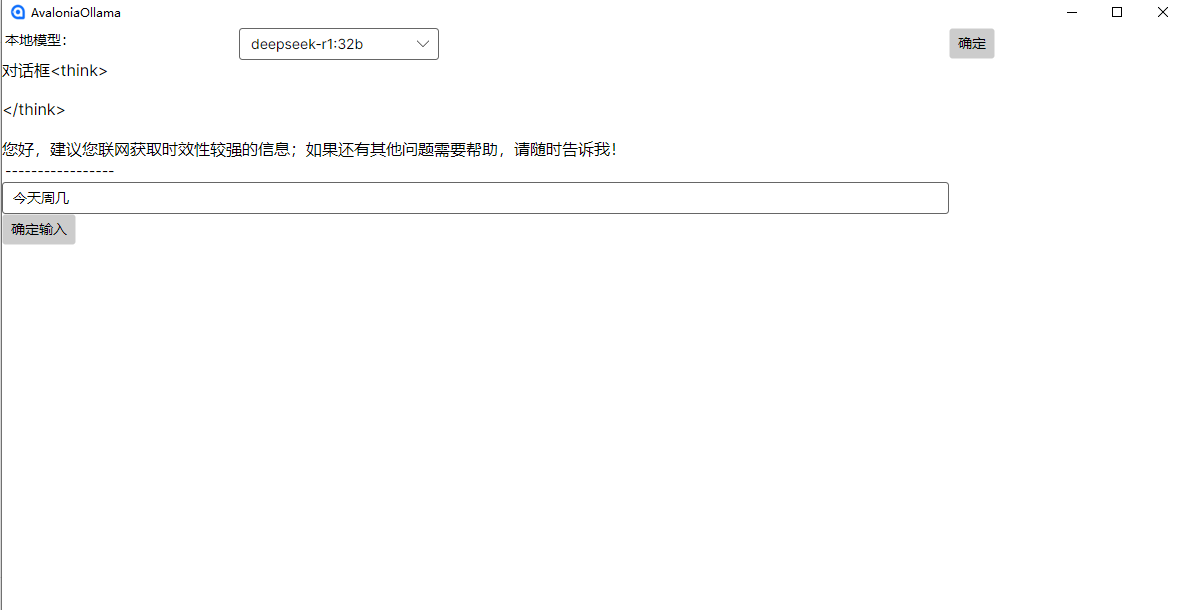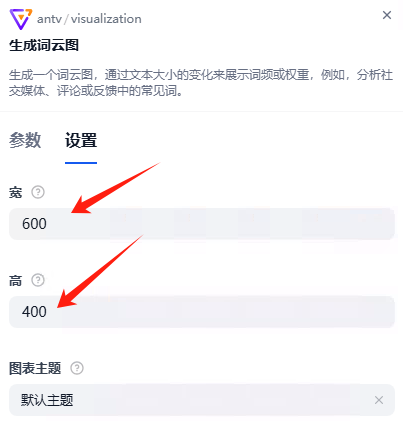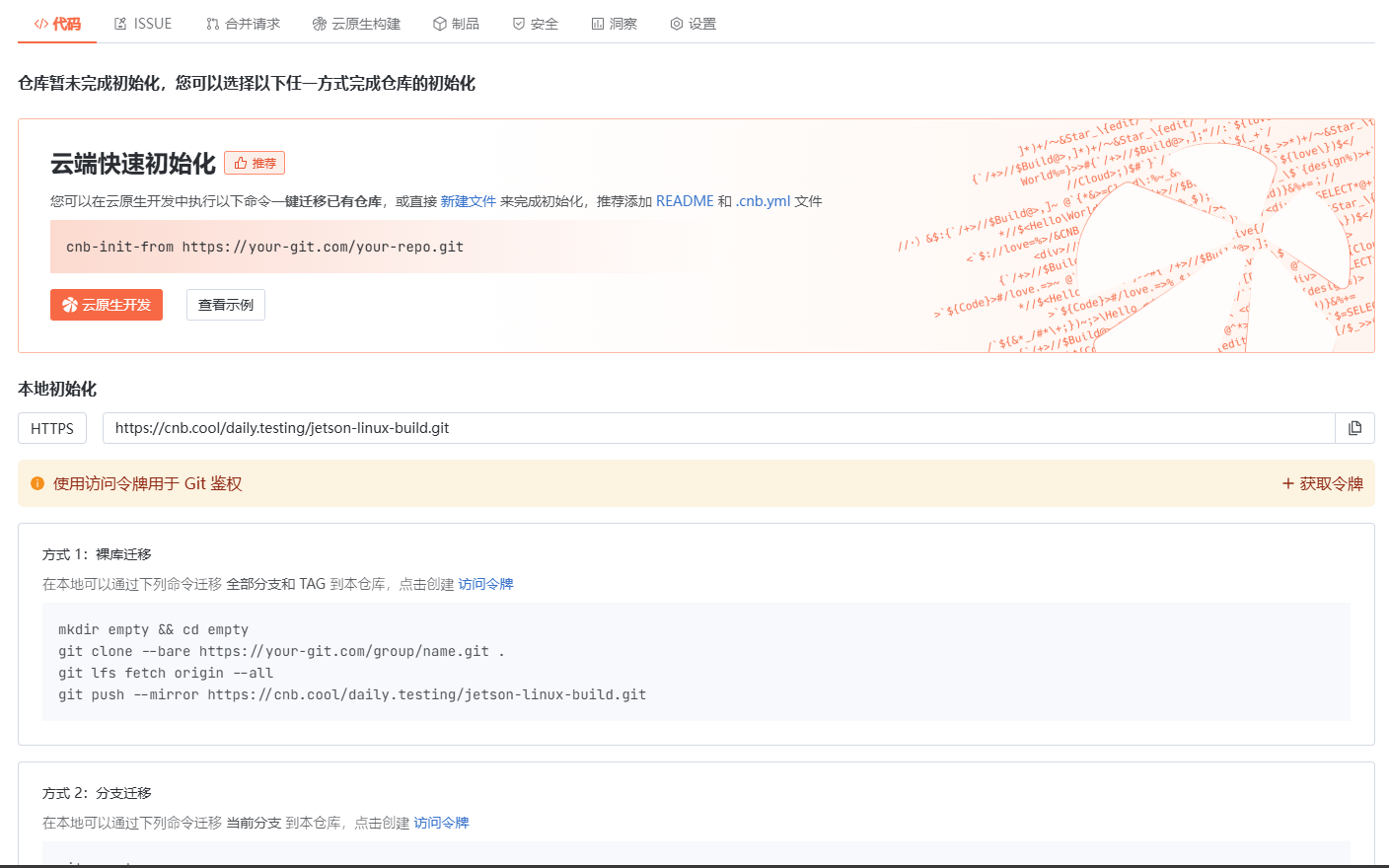Open3D解决SceneWidget加入布局中消失的问题
Open3D解决SceneWidget加入布局中消失的问题
- Open3D解决SceneWidget加入布局中消失的问题
- 1. 问题
- 2. 问题代码
- 3. 解决
Open3D解决SceneWidget加入布局中消失的问题
1. 问题
把SceneWidget加到布局管理其中图形可以展示出来,但是鼠标点击就消失了。
stackoverflow上已经有人提出这个问题了,还是2022年的时候,可是现在好像也没有解决。
https://stackoverflow.com/questions/71706506/why-does-open3d-visualization-disappear-when-i-left-click-the-window
2. 问题代码

# ----------------------------------------------------------------------------
# - Open3D: www.open3d.org -
# ----------------------------------------------------------------------------
# Copyright (c) 2018-2024 www.open3d.org
# SPDX-License-Identifier: MIT
# ----------------------------------------------------------------------------import open3d as o3d
import open3d.visualization.gui as gui
import open3d.visualization.rendering as rendering
import platform
import random
import threading
import timeisMacOS = (platform.system() == "Darwin")# This example shows two methods of adding geometry to an existing scene.
# 1) add via a UI callback (in this case a menu, but a button would be similar,
# you would call `button.set_on_clicked(self.on_menu_sphere_)` when
# configuring the button. See `on_menu_sphere()`.
# 2) add asynchronously by polling from another thread. GUI functions must be
# called from the UI thread, so use Application.post_to_main_thread().
# See `on_menu_random()`.
# Running the example will show a simple window with a Debug menu item with the
# two different options. The second method will add random spheres for
# 20 seconds, during which time you can be interacting with the scene, rotating,
# etc.
class SpheresApp:MENU_SPHERE = 1MENU_RANDOM = 2MENU_QUIT = 3def __init__(self):self._id = 0self.window = gui.Application.instance.create_window("Add Spheres Example", 800, 600)# The menu is global (because the macOS menu is global), so only create# it once, no matter how many windows are createdif gui.Application.instance.menubar is None:if isMacOS:app_menu = gui.Menu()app_menu.add_item("Quit", SpheresApp.MENU_QUIT)debug_menu = gui.Menu()debug_menu.add_item("Add Sphere", SpheresApp.MENU_SPHERE)debug_menu.add_item("Add Random Spheres", SpheresApp.MENU_RANDOM)if not isMacOS:debug_menu.add_separator()debug_menu.add_item("Quit", SpheresApp.MENU_QUIT)menu = gui.Menu()if isMacOS:# macOS will name the first menu item for the running application# (in our case, probably "Python"), regardless of what we call# it. This is the application menu, and it is where the# About..., Preferences..., and Quit menu items typically go.menu.add_menu("Example", app_menu)menu.add_menu("Debug", debug_menu)else:menu.add_menu("Debug", debug_menu)gui.Application.instance.menubar = menu# The menubar is global, but we need to connect the menu items to the# window, so that the window can call the appropriate function when the# menu item is activated.self.window.set_on_menu_item_activated(SpheresApp.MENU_SPHERE,self._on_menu_sphere)self.window.set_on_menu_item_activated(SpheresApp.MENU_RANDOM,self._on_menu_random)self.window.set_on_menu_item_activated(SpheresApp.MENU_QUIT,self._on_menu_quit)self.scene = gui.SceneWidget()self.scene.scene = rendering.Open3DScene(self.window.renderer)self.scene.scene.show_axes(True)mesh = o3d.geometry.TriangleMesh.create_sphere()mesh.compute_vertex_normals()material = rendering.MaterialRecord()material.shader = "defaultLit"self.scene.scene.add_geometry("sphere" + str(self._id), mesh, material)em = self.window.theme.font_sizeself.layout = gui.Horiz(0, gui.Margins(0.25*em,0.25*em,0.25*em,0.254*em))self.layout.add_child(gui.Label("Model file"))self.layout.add_fixed(0.25 * em)self.window.set_on_layout(self.on_window_layout)self.vlayout = gui.Vert(0, gui.Margins(0.25 * em, 0.25 * em, 0.25 * em, 0.254 * em))self.vlayout.add_child(self.scene)self.vlayout.add_fixed(0.25 * em)self.window.add_child(self.vlayout)self.window.add_child(self.layout)def on_window_layout(self, layout: gui.LayoutContext) -> None:"""This is called when layout is required for this widgets *immediate children*, like on resize. Only the immediatechildren are *manually* positioned here, by setting the x, y, width, and height of their frames. Thegrandchildren are *not* touched here; they're automatically handled after this."""# This is the area in this widget available to place child widgets in. The *units* here aren't window screen# pixels, like from the width/height here when setting up the window: gui.Application.instance.create_window("Test", width=500, height=600).rect = self.window.content_rectr = self.window.content_rectprint(r)print(layout.theme.default_layout_spacing)print(layout.theme.default_margin)print(layout.theme.font_size)# Put the layout (containing the controls) on the left 1/3 and the and scene on the right 2/3.x_division = rect.width // 3# Set the layout (gui.Vert) on left to 1/3 available width, full height.# gui.Rect(x, y, width, height)# Set the SceneWidget on on right, 2/3 available width, full heightself.vlayout.frame = gui.Rect(0, 0, r.width - x_division, r.height)self.layout.frame = gui.Rect(r.width - x_division, 0, x_division, r.height)def add_sphere(self):self._id += 1mat = rendering.MaterialRecord()mat.base_color = [random.random(),random.random(),random.random(), 1.0]mat.shader = "defaultLit"sphere = o3d.geometry.TriangleMesh.create_sphere(0.5)sphere.compute_vertex_normals()sphere.translate([10.0 * random.uniform(-1.0, 1.0), 10.0 * random.uniform(-1.0, 1.0),10.0 * random.uniform(-1.0, 1.0)])self.scene.scene.add_geometry("sphere" + str(self._id), sphere, mat)def _on_menu_sphere(self):# GUI callbacks happen on the main thread, so we can do everything# normally here.self.scene.scene.clear_geometry()self.add_sphere()def _on_menu_random(self):# This adds spheres asynchronously. This pattern is useful if you have# data coming in from another source than user interaction.def thread_main():for _ in range(0, 20):# We can only modify GUI objects on the main thread, so we# need to post the function to call to the main thread.gui.Application.instance.post_to_main_thread(self.window, self.add_sphere)time.sleep(0.5)threading.Thread(target=thread_main).start()def _on_menu_quit(self):gui.Application.instance.quit()def main():gui.Application.instance.initialize()SpheresApp()gui.Application.instance.run()if __name__ == "__main__":main()3. 解决
不能放在布局中就直接手动布局吧,
不加到布局中去。。。

# ----------------------------------------------------------------------------
# - Open3D: www.open3d.org -
# ----------------------------------------------------------------------------
# Copyright (c) 2018-2024 www.open3d.org
# SPDX-License-Identifier: MIT
# ----------------------------------------------------------------------------import open3d as o3d
import open3d.visualization.gui as gui
import open3d.visualization.rendering as rendering
import platform
import random
import threading
import timeisMacOS = (platform.system() == "Darwin")# This example shows two methods of adding geometry to an existing scene.
# 1) add via a UI callback (in this case a menu, but a button would be similar,
# you would call `button.set_on_clicked(self.on_menu_sphere_)` when
# configuring the button. See `on_menu_sphere()`.
# 2) add asynchronously by polling from another thread. GUI functions must be
# called from the UI thread, so use Application.post_to_main_thread().
# See `on_menu_random()`.
# Running the example will show a simple window with a Debug menu item with the
# two different options. The second method will add random spheres for
# 20 seconds, during which time you can be interacting with the scene, rotating,
# etc.
class SpheresApp:MENU_SPHERE = 1MENU_RANDOM = 2MENU_QUIT = 3def __init__(self):self._id = 0self.window = gui.Application.instance.create_window("Add Spheres Example", 800, 600)# The menu is global (because the macOS menu is global), so only create# it once, no matter how many windows are createdif gui.Application.instance.menubar is None:if isMacOS:app_menu = gui.Menu()app_menu.add_item("Quit", SpheresApp.MENU_QUIT)debug_menu = gui.Menu()debug_menu.add_item("Add Sphere", SpheresApp.MENU_SPHERE)debug_menu.add_item("Add Random Spheres", SpheresApp.MENU_RANDOM)if not isMacOS:debug_menu.add_separator()debug_menu.add_item("Quit", SpheresApp.MENU_QUIT)menu = gui.Menu()if isMacOS:# macOS will name the first menu item for the running application# (in our case, probably "Python"), regardless of what we call# it. This is the application menu, and it is where the# About..., Preferences..., and Quit menu items typically go.menu.add_menu("Example", app_menu)menu.add_menu("Debug", debug_menu)else:menu.add_menu("Debug", debug_menu)gui.Application.instance.menubar = menu# The menubar is global, but we need to connect the menu items to the# window, so that the window can call the appropriate function when the# menu item is activated.self.window.set_on_menu_item_activated(SpheresApp.MENU_SPHERE,self._on_menu_sphere)self.window.set_on_menu_item_activated(SpheresApp.MENU_RANDOM,self._on_menu_random)self.window.set_on_menu_item_activated(SpheresApp.MENU_QUIT,self._on_menu_quit)self.scene = gui.SceneWidget()self.scene.scene = rendering.Open3DScene(self.window.renderer)self.scene.scene.show_axes(True)mesh = o3d.geometry.TriangleMesh.create_sphere()mesh.compute_vertex_normals()material = rendering.MaterialRecord()material.shader = "defaultLit"self.scene.scene.add_geometry("sphere" + str(self._id), mesh, material)em = self.window.theme.font_sizeself.layout = gui.Horiz(0, gui.Margins(0.25*em,0.25*em,0.25*em,0.254*em))self.layout.add_child(gui.Label("Model file"))self.layout.add_fixed(0.25 * em)self.window.set_on_layout(self.on_window_layout)self.window.add_child(self.scene)self.window.add_child(self.layout)def on_window_layout(self, layout: gui.LayoutContext) -> None:"""This is called when layout is required for this widgets *immediate children*, like on resize. Only the immediatechildren are *manually* positioned here, by setting the x, y, width, and height of their frames. Thegrandchildren are *not* touched here; they're automatically handled after this."""# This is the area in this widget available to place child widgets in. The *units* here aren't window screen# pixels, like from the width/height here when setting up the window: gui.Application.instance.create_window("Test", width=500, height=600).rect = self.window.content_rectr = self.window.content_rectprint(r)print(layout.theme.default_layout_spacing)print(layout.theme.default_margin)print(layout.theme.font_size)# Put the layout (containing the controls) on the left 1/3 and the and scene on the right 2/3.x_division = rect.width // 3# Set the layout (gui.Vert) on left to 1/3 available width, full height.# gui.Rect(x, y, width, height)# Set the SceneWidget on on right, 2/3 available width, full heightself.scene.frame = gui.Rect(0, 0, r.width - x_division, r.height)self.layout.frame = gui.Rect(r.width - x_division, 0, x_division, r.height)def add_sphere(self):self._id += 1mat = rendering.MaterialRecord()mat.base_color = [random.random(),random.random(),random.random(), 1.0]mat.shader = "defaultLit"sphere = o3d.geometry.TriangleMesh.create_sphere(0.5)sphere.compute_vertex_normals()sphere.translate([10.0 * random.uniform(-1.0, 1.0), 10.0 * random.uniform(-1.0, 1.0),10.0 * random.uniform(-1.0, 1.0)])self.scene.scene.add_geometry("sphere" + str(self._id), sphere, mat)def _on_menu_sphere(self):# GUI callbacks happen on the main thread, so we can do everything# normally here.self.scene.scene.clear_geometry()self.add_sphere()def _on_menu_random(self):# This adds spheres asynchronously. This pattern is useful if you have# data coming in from another source than user interaction.def thread_main():for _ in range(0, 20):# We can only modify GUI objects on the main thread, so we# need to post the function to call to the main thread.gui.Application.instance.post_to_main_thread(self.window, self.add_sphere)time.sleep(0.5)threading.Thread(target=thread_main).start()def _on_menu_quit(self):gui.Application.instance.quit()def main():gui.Application.instance.initialize()SpheresApp()gui.Application.instance.run()if __name__ == "__main__":main()相关文章:

Open3D解决SceneWidget加入布局中消失的问题
Open3D解决SceneWidget加入布局中消失的问题 Open3D解决SceneWidget加入布局中消失的问题1. 问题2. 问题代码3. 解决 Open3D解决SceneWidget加入布局中消失的问题 1. 问题 把SceneWidget加到布局管理其中图形可以展示出来,但是鼠标点击就消失了。 stackoverflow上已…...

计算机毕业设计Python+DeepSeek-R1大模型游戏推荐系统 Steam游戏推荐系统 游戏可视化 游戏数据分析(源码+文档+PPT+讲解)
温馨提示:文末有 CSDN 平台官方提供的学长联系方式的名片! 温馨提示:文末有 CSDN 平台官方提供的学长联系方式的名片! 温馨提示:文末有 CSDN 平台官方提供的学长联系方式的名片! 作者简介:Java领…...

Linux笔记---缓冲区
1. 什么是缓冲区 在计算机系统中,缓冲区(Buffer) 是一种临时存储数据的区域,主要用于协调不同速度或不同时序的组件之间的数据传输,以提高效率并减少资源冲突。它是系统设计中的重要概念,尤其在I/O操作、网…...

如何流畅访问github
1.传输数据原理 本地计算机通过本地网接入运营骨干网,经过DNS域名解析,将输入的字符解析为要连接的真实IP地址,服务器返还一个数据包(github)给计算机 2.原因 DNS域名污染-DNS解析出现问题,导致访问一个不存在的服务器 3.解决…...

java基础+面向对象
Java基础语法 CMD命令 cls 清屏 cd 目录进入文件 cd… 退回 dir 查看当前目录所有文件 E:进入E盘 exit 退出 环境变量就是不用去专门的盘符去找,直接去环境变量里找到文件 语言优势 编译型语言c: 整体翻译 解释型语言python&#x…...

Linux 检测内存泄漏方法总结
文章目录 strace检测asan内存检测linux下gperf工具(tcmalloc)检查C/C代码内存泄露问题参考 strace检测 (1)启动程序 (2) strace -f -p <PID> -tt -e brk,mmap,mmap2,munmapbrk 变大 → 说明堆增长…...

本地部署deepseek大模型后使用c# winform调用(可离线)
介于最近deepseek的大火,我就在想能不能用winform也玩一玩本地部署,于是经过查阅资料,然后了解到ollama部署deepseek,最后用ollama sharp NUGet包来实现winform调用ollama 部署的deepseek。 本项目使用Vs2022和.net 8.0开发,ollam…...

Python----数据分析(Numpy:安装,数组创建,切片和索引,数组的属性,数据类型,数组形状,数组的运算,基本函数)
一、 Numpy库简介 1.1、概念 NumPy(Numerical Python)是一个开源的Python科学计算库,旨在为Python提供 高性能的多维数组对象和一系列工具。NumPy数组是Python数据分析的基础,许多 其他的数据处理库(如Pandas、SciPy)都依赖于Num…...

Leetcode-最大矩形(单调栈)
一、题目描述 给定一个仅包含 0 和 1 、大小为 rows x cols 的二维二进制矩阵,找出只包含 1 的最大矩形,并返回其面积。 输入:matrix [["1","0","1","0","0"],["1","0&…...

域内委派维权
为某个服务账户配置 krbtgt 用户的非约束性委派或基于资源的约束性委派。这里我的 krbtgt 的基于资源约束性委派我利用不了,所以使用的是域控的机器账户 dc01$ 进行维权。 抓取所有 hash。 mimikatz.exe "privilege::debug" "lsadump::dcsync /doma…...

leetcode---LCR 140.训练计划
给定一个头节点为 head 的链表用于记录一系列核心肌群训练项目编号,请查找并返回倒数第 cnt 个训练项目编号。 示例 1: 输入:head [2,4,7,8], cnt 1 输出:8 提示: 1 < head.length < 1000 < head[i] <…...
整理)
Linux基础 -- ARM 32位常用机器码(指令)整理
ARM 32位常用机器码(指令)整理 1. 数据处理指令(运算、逻辑、比较) 指令含义示例备注MOV赋值(寄存器传输)MOV R0, R1直接将 R1 复制到 R0MVN取反MVN R0, R1R0 ~R1ADD加法ADD R0, R1, R2R0 R1 R2ADC带进…...

内存中的缓存区
在 Java 的 I/O 流设计中,BufferedInputStream 和 BufferedOutputStream 的“缓冲区”是 内存中的缓存区(具体是 JVM 堆内存的一部分),但它们的作用是优化数据的传输效率,并不是直接操作硬盘和内存之间的缓存。以下是详…...

基于 Spring Boot 的 +Vue“宠物咖啡馆平台” 系统的设计与实现
大家好,今天要和大家聊的是一款基于 Spring Boot 的 “宠物咖啡馆平台” 系统的设计与实现。项目源码以及部署相关事宜请联系我,文末附上联系方式。 项目简介 基于 Spring Boot 的 “宠物咖啡馆平台” 系统设计与实现的主要使用者分为 管理员、用户 和…...

LeetCode 解题思路 7(Hot 100)
解题思路: 初始化窗口元素: 遍历前 k 个元素,构建初始单调队列。若当前索引对应值大于等于队尾索引对应值,移除队尾索引,将当前索引加入队尾。遍历结束时当前队头索引即为当前窗口最大值,将其存入结果数组…...

linux-Dockerfile及docker-compose.yml相关字段用途
文章目录 计算机系统5G云计算LINUX Dockerfile及docker-conpose.yml相关字段用途一、Dockerfile1、基础指令2、.高级指令3、多阶段构建指令 二、Docker-Compose.yml1、服务定义(services)2、高级服务配置3、网络配置 (networks)4、卷配置 (volumes)5、扩…...

deepseek部署:ELK + Filebeat + Zookeeper + Kafka
## 1. 概述 本文档旨在指导如何在7台机器上部署ELK(Elasticsearch, Logstash, Kibana)堆栈、Filebeat、Zookeeper和Kafka。该部署方案适用于日志收集、处理和可视化场景。 ## 2. 环境准备 ### 2.1 机器分配 | 机器编号 | 主机名 | IP地址 | 部署组件 |-…...
微软Office 2016-2024 x86直装版 v16.0.18324 32位
微软 Office 是一款由微软公司开发的办公软件套装,能满足各种办公需求。包含 Word、Excel、PowerPoint、Outlook 和 OneNote 等软件。Word 有强大文档编辑功能和多人协作;Excel 可处理分析大量数据及支持宏编程;PowerPoint 用于制作演示文稿且…...

CMake宏定义管理:如何优雅处理第三方库的宏冲突
在C/C项目开发中,我们常常会遇到这样的困境: 当引入一个功能强大的第三方库时,却发现它定义的某个宏与我们的项目产生冲突。比如: 库定义了 BUFFER_SIZE 1024,而我们需要 BUFFER_SIZE 2048库内部使用 DEBUG 宏控制日志…...

【SpringCloud】Gateway
目录 一、网关路由 1.1.认识网关 1.2.快速入门? 1.2.1.引入依赖 1.2.2.配置路由 二、网关登录校验 2.1.Gateway工作原理 ?2.2.自定义过滤器 2.3.登录校验 2.4.微服务获取用户 2.4.1.保存用户信息到请求头 2.4.2.拦截器获取用户? ?2.5.OpenFeign传递用户 三、…...

以下是对华为 HarmonyOS NETX 5属性动画(ArkTS)文档的结构化整理,通过层级标题、表格和代码块提升可读性:
一、属性动画概述NETX 作用:实现组件通用属性的渐变过渡效果,提升用户体验。支持属性:width、height、backgroundColor、opacity、scale、rotate、translate等。注意事项: 布局类属性(如宽高)变化时&#…...
)
【位运算】消失的两个数字(hard)
消失的两个数字(hard) 题⽬描述:解法(位运算):Java 算法代码:更简便代码 题⽬链接:⾯试题 17.19. 消失的两个数字 题⽬描述: 给定⼀个数组,包含从 1 到 N 所有…...

【大模型RAG】Docker 一键部署 Milvus 完整攻略
本文概要 Milvus 2.5 Stand-alone 版可通过 Docker 在几分钟内完成安装;只需暴露 19530(gRPC)与 9091(HTTP/WebUI)两个端口,即可让本地电脑通过 PyMilvus 或浏览器访问远程 Linux 服务器上的 Milvus。下面…...

Python如何给视频添加音频和字幕
在Python中,给视频添加音频和字幕可以使用电影文件处理库MoviePy和字幕处理库Subtitles。下面将详细介绍如何使用这些库来实现视频的音频和字幕添加,包括必要的代码示例和详细解释。 环境准备 在开始之前,需要安装以下Python库:…...

c#开发AI模型对话
AI模型 前面已经介绍了一般AI模型本地部署,直接调用现成的模型数据。这里主要讲述讲接口集成到我们自己的程序中使用方式。 微软提供了ML.NET来开发和使用AI模型,但是目前国内可能使用不多,至少实践例子很少看见。开发训练模型就不介绍了&am…...

dify打造数据可视化图表
一、概述 在日常工作和学习中,我们经常需要和数据打交道。无论是分析报告、项目展示,还是简单的数据洞察,一个清晰直观的图表,往往能胜过千言万语。 一款能让数据可视化变得超级简单的 MCP Server,由蚂蚁集团 AntV 团队…...

Java线上CPU飙高问题排查全指南
一、引言 在Java应用的线上运行环境中,CPU飙高是一个常见且棘手的性能问题。当系统出现CPU飙高时,通常会导致应用响应缓慢,甚至服务不可用,严重影响用户体验和业务运行。因此,掌握一套科学有效的CPU飙高问题排查方法&…...

云原生玩法三问:构建自定义开发环境
云原生玩法三问:构建自定义开发环境 引言 临时运维一个古董项目,无文档,无环境,无交接人,俗称三无。 运行设备的环境老,本地环境版本高,ssh不过去。正好最近对 腾讯出品的云原生 cnb 感兴趣&…...

Python ROS2【机器人中间件框架】 简介
销量过万TEEIS德国护膝夏天用薄款 优惠券冠生园 百花蜂蜜428g 挤压瓶纯蜂蜜巨奇严选 鞋子除臭剂360ml 多芬身体磨砂膏280g健70%-75%酒精消毒棉片湿巾1418cm 80片/袋3袋大包清洁食品用消毒 优惠券AIMORNY52朵红玫瑰永生香皂花同城配送非鲜花七夕情人节生日礼物送女友 热卖妙洁棉…...

Java毕业设计:WML信息查询与后端信息发布系统开发
JAVAWML信息查询与后端信息发布系统实现 一、系统概述 本系统基于Java和WML(无线标记语言)技术开发,实现了移动设备上的信息查询与后端信息发布功能。系统采用B/S架构,服务器端使用Java Servlet处理请求,数据库采用MySQL存储信息࿰…...
